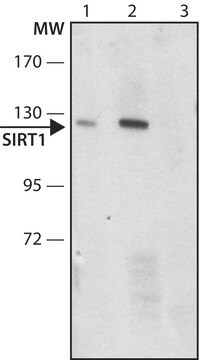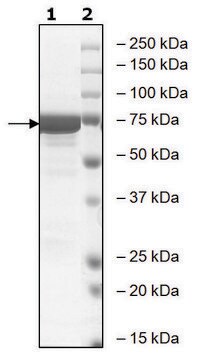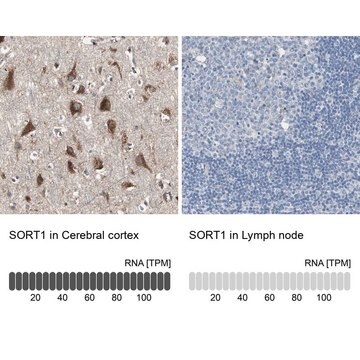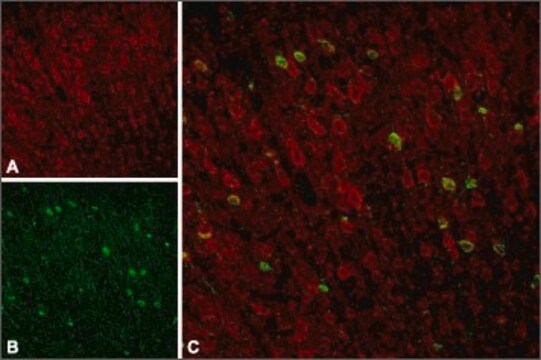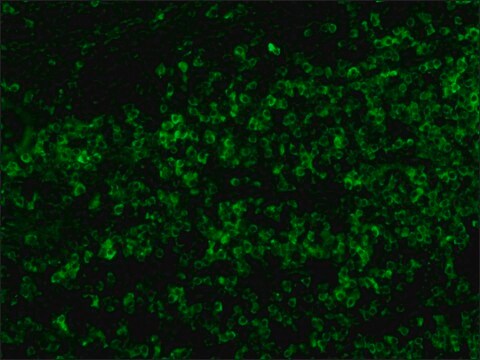MABN1792
Anti-Sortilin Antibody, clone F11
clone F11, from mouse
Sinónimos:
Sortilin, 100 kDa NT receptor, Glycoprotein 95, Gp95, Neurotensin receptor 3, NT3, NTR3
About This Item
ICC
IHC
WB
immunocytochemistry: suitable
immunohistochemistry: suitable (paraffin)
western blot: suitable
Productos recomendados
origen biológico
mouse
Nivel de calidad
forma del anticuerpo
purified immunoglobulin
tipo de anticuerpo
primary antibodies
clon
F11, monoclonal
reactividad de especies
mouse, human
técnicas
ELISA: suitable
immunocytochemistry: suitable
immunohistochemistry: suitable (paraffin)
western blot: suitable
isotipo
IgG1κ
Nº de acceso NCBI
Nº de acceso UniProt
Condiciones de envío
wet ice
modificación del objetivo postraduccional
unmodified
Información sobre el gen
human ... SORT1(6272)
Descripción general
Inmunógeno
Aplicación
Immunocytochemistry Analysis: Representative lots detected cellular localization of exogenously expressed sortilin in transfected HEK293 cells by fluorescent immunocytochemistry (Larsen, J.V., et al. (2014). Biochem J. 457(2):277-288; Gustafsen, C., et al. (2013). J Neurosci. 33(1):64-71; Larsen, J.V., et al. (2010). Mol. Cell. Biol. 30(17):4175-4187; Nielsen, M.S., et al. (2007). Mol. Cell. Biol. 27(19):6842-6851).
ELISA Analysis: A representative lot was employed as the detection antibody in sandwich ELISA. A positive correlation was found between PCSK9 and soluble sortilin in human serum samples from healthy individuals (Gustafsen, C., et al. (2014). Cell Metab. 19(2):310-318).
Western Blotting Analysis: A representative lot detected different distribution of Sortilin than SorLA among subcellular fractions obtained by gradient centrifugation (Nielsen, M.S., et al. (2007). Mol. Cell. Biol. 27(19):6842-6851).
Neuroscience
Developmental Neuroscience
Calidad
Immunohistochemistry Analysis: A 1:50 dilution of this antibody detected Sortilin in human cerebral cortex tissue.
Descripción de destino
Forma física
Almacenamiento y estabilidad
Otras notas
Cláusula de descargo de responsabilidad
¿No encuentra el producto adecuado?
Pruebe nuestro Herramienta de selección de productos.
Código de clase de almacenamiento
12 - Non Combustible Liquids
Clase de riesgo para el agua (WGK)
WGK 1
Punto de inflamabilidad (°F)
Not applicable
Punto de inflamabilidad (°C)
Not applicable
Certificados de análisis (COA)
Busque Certificados de análisis (COA) introduciendo el número de lote del producto. Los números de lote se encuentran en la etiqueta del producto después de las palabras «Lot» o «Batch»
¿Ya tiene este producto?
Encuentre la documentación para los productos que ha comprado recientemente en la Biblioteca de documentos.
Nuestro equipo de científicos tiene experiencia en todas las áreas de investigación: Ciencias de la vida, Ciencia de los materiales, Síntesis química, Cromatografía, Analítica y muchas otras.
Póngase en contacto con el Servicio técnico

